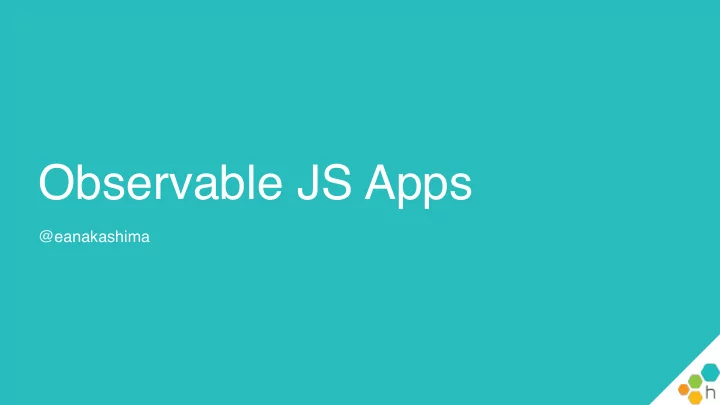

Observable JS Apps @eanakashima
about:// Emily Nakashima product engineering manager @ honeycomb.io
The one where we DDOS’d ourselves
Epilogue
// if the page is long enough to scroll if (document.body.clientHeight > window.innerHeight) { // add a scroll event listener document.addEventListener('scroll', function(e) { // if within 100px of the bottom of the page if (window.innerHeight + window.scrollY + 100 > document.body.clientHeight) fetchNextPage(); }); // else fetch another page of results immediately } else { fetchNextPage(); }
We had lots of production data 1. Product Analytics 2. Metrics 3. Client-side metrics 4. Error monitoring 5. Logs
What data (or graphs) would have helped? • Total traffic count broken down into buckets by screen size. • Average number of API requests triggered by a particular page type.
Frontend complexity is only increasing
Observability Instrument your code so that you can: ‣ ask any question, whether you anticipated it or not ‣ deeply understand the state of your system by observing its outputs
Backend Instrumentation
Honeycomb Architecture
Types of production data 1. Metrics 2. Events: sent to Honeycomb • Plus a few other tools that are “event-y” 1. Logs (structured, no log aggregator) 2. Traces (sometimes) 3. Error monitoring 3. Product Analytics
What’s in an event? { "GojiPattern": "\/user_event\/:event_type", "Header.Content-Type": "[\"application\/json\"]", "Header.Cookie": "[\"_ga=GA1.2.2033006133.1516389900;", "Header.User-Agent": "[\"Mozilla\/5.0 (Macintosh; Intel Mac OS X 10_13_1)…\”]”, "Host": "127.0.0.1:8080", "IsXHR": true, "Method": "POST", "RequestURI": "\/user_event\/page-unload", "ResponseContentLength": 443, "ResponseHttpStatus": 200, "ResponseTime_ms": 123, "Timestamp": "2018-03-02T06:14:57.206349701Z", "UserEmail": "nathan@honeycomb.io", "UserID": 18, "availability_zone": "us-east-1b", "build_id": "6552", "env": "dogfood", "infra_type": "aws_instance", "instance_type": "t2.micro", "memory_inuse": 15450056, "num_goroutines": 56, "request_id": "poodle-a38f5e39\/5fIUGkX5D1-001814", "server_hostname": "poodle-a38f5e39", "type": "request" },
High cardinality Fields that may have many unique values Common examples: • email address • username / user id / team id • server hostname • IP address • user agent string • build id • request url • feature flags / flag combinations
What’s in an event? { "GojiPattern": "\/user_event\/:event_type", "Header.Content-Type": "[\"application\/json\"]", "Header.Cookie": "[\"_ga=GA1.2.2033006133.1516389900;", "Header.User-Agent": "[\"Mozilla\/5.0 (Macintosh; Intel Mac OS X 10_13_1)…\”]”, "Host": "127.0.0.1:8080", "IsXHR": true, "Method": "POST", "RequestURI": "\/user_event\/page-unload", "ResponseContentLength": 443, "ResponseHttpStatus": 200, "ResponseTime_ms": 123, "Timestamp": "2018-03-02T06:14:57.206349701Z", "UserEmail": "nathan@honeycomb.io", "UserID": 18, "availability_zone": "us-east-1b", "build_id": "6552", "env": "dogfood", "infra_type": "aws_instance", "instance_type": "t2.micro", "memory_inuse": 15450056, "num_goroutines": 56, "request_id": "poodle-a38f5e39\/5fIUGkX5D1-001814", "server_hostname": "poodle-a38f5e39", "type": "request" },
Browser Instrumentation
Honeycomb Query Sandbox: React, SCSS, go templates, and lots of data
Instrumentation toolkit I. Performance RAIL model Loading metrics: page load time, resource load time, first paint. II. Errors An event per client-side javascript error, with metadata like stack trace & event breadcrumb trail
RAIL performance model https://developers.google.com/web/fundamentals/performance/rail
Instrumentation toolkit I. Performance RAIL model Loading metrics: page load time, resource load time, first paint. II. Errors An event per client-side javascript error, with metadata like stack trace & event breadcrumb trail
Instrumentation code I. Performance Write a custom thing But actually, use Boomerang II. Errors Sentry’s Raven JS is o/s So is Bugsnag’s … or write a custom thing (no)
When we fire events 1. On page load 2. On SPA navigation 3. On significant user actions 4. On page unload
Sample page load event { // App-specific type: “page-navigation", page_type: “/:team/datasets/:dataset", user_id: 123, ab_groups:{ touch_ui: true, multi_team_chat: false } // Performance / Environment page_load_time_ms: 2145 // plus all navigation timing metrics resource_count: 21 asset_version: "1.232.90" canary: false request_id: 123456, // Capabilities user_agent: "Mozilla/5.0 (Macintosh; Intel Mac OS X 10_12_6) SomeBrowser/123.45" window_height: 822, window_width: 1145, screen_height: 800, screen_width: 1245, feature_support_emoji: true, feature_support_service_worker: false, }
More browser context • Installed fonts • Screen dimensions & color depth • Browser language • Online/offline status • Page visibility (backgrounded?) • Connection type • Support for emerging browser APIs • Geographical location (using a library*)
Sample SPA navigation event { // Usage type: "react-router-navigation", page_type: "/:team/datasets/:dataset”, user_id: 123, ab_group_touch_ui: true, ab_group_multi_team_chat: false, request_id: 123456, // Performance / Regression api_request_duration_ms: 2145, api_response_parse_duration_ms 12, component_render_duration_ms: 42, }
Sample user action event { // Usage type: "user-derived-column-add", page_type: "/:team/datasets/:dataset", user_id: 123, ab_groups: { touch_ui: true, multi_team_chat: false, } request_id: 123456, feature_column_type: "number", }
Sample page unload event { // Usage type: "react-router-navigation", page_type: “/:team/datasets/:dataset", user_id: 123, ab_group_touch_ui: true, ab_group_multi_team_chat: false, // Performance / Regression request_id: 123456, js_error_count: 0, window_open_duration_s: 45003, // Memory info (Chrome) — also send this on load so we can compare heap size // and understand how much memory we're using as the user interacts with the page. js_heap_size_used_b: 123455, js_heap_change_b: 20000, }
Honeycomb Query Sandbox: what we graph
Honeycomb Query Sandbox: what we graph
Honeycomb Query Sandbox: what we graph
Honeycomb Query Sandbox: what we graph
Tool Choice
Tool choice: where to send events? Places to send events (if you don’t use Honeycomb) 1. Log aggregator 2. Metrics tools with support for high cardinality labels/tags 3. Error monitoring tool (maybe)
Debugging performance
Understanding Normal
Understanding Normal
Understanding Normal
Understanding Normal
Looking ahead Using observability to drive design
Using observability to drive design
Using observability to drive design
Using observability to drive design
Using observability to drive design
Using observability to drive design
Using observability to drive design
Understanding Normal Server-side rendering vs. client side rendering
Understanding normal
Page load event with server timings { type: “page-navigation", page_type: “/:team/datasets/:dataset", // Performance / Environment page_load_time_ms: 2145 // plus all navigation timing metrics resource_count: 21 asset_version: "1.232.90" canary: false // Already have this from window.performance navigation server_request_dur_ms: performance.timing.responseEnd - performance.timing.navigationStart, // New timings template_server_render_dur_ms: 12, time_to_component_rendered_ms: { dataset_usage_viz: 156 }, request_id: 123456, }
// capture time-to-component-rendered with react class DatasetUsageViz extends React.Component { componentDidMount() { // updatePageLoadEventPayload will merge this payload with // our global event context so these fields appear on the // page-load or page-unload event. updatePageLoadEventPayload({ time_to_component_rendered_ms: { dataset_usage_viz: window.performance.now() }, }); }; // ... }
Recommend
More recommend